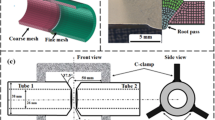Abstract
The cross wedge rolling (CWR) deformation and fracture of a Ti6Al4Al (ELI) alloy were investigated experimentally and numerically using a coupled thermo-mechanical finite element model analysis. The experimentally determined flow stress and damage model parameters were verified by tension split Hopkinson pressure bar testing of notched samples. The simulation and experimental CWR forces showed well agreements except near the end of the stretching zone. The model analysis showed that the temperature distribution in the work piece was non-uniform during the CWR. When the initial temperature of the work piece was relatively low, the work piece temperature increased, a heating effect of the plastic deformation, while relatively high initial work piece temperatures resulted in cooling the work piece, caused by the work piece contact with the tools. The cracks were shown numerically to initiate in the midsections of the work piece during the guiding action and elongated in a direction normal to the maximum tensile stress triaxiality, resulting in cruciform-shaped crack formation, which was well agreed with the previously observed crack shape.
Similar content being viewed by others
References
Pater Z (1995) Theoretical method for estimation of mean pressure on contact area between rolling tools and workpiece in cross wedge rolling processes. In: International Conference on the Advances in Materials Processing Technologies (AMPT 95), Dublin, Ireland, Aug 1995. Pergamon-Elsevier, Oxford, pp. 233–243
Dong Y, Tagavi KA, Lovell MR (2000) Analysis of interfacial slip in cross-wedge rolling: a numerical and phenomenological investigation. J Mater Process Technol 97(1–3):44–53
Pater Z (1998) A study of cross wedge rolling process. J Mater Process Technol 80–1:370–375
Johnson W, Mamalis AG (1977) A survey of some physical defects arising in metal working processes. Paper presented at the Proc 17th International MTDR Conference, London, UK
Dong YM, Tagavi KA, Lovell MR, Deng Z (2000) Analysis of stress in cross wedge rolling with application to failure. Int J Mech Sci 42(7):1233–1253
Li Q, Lovell MR (2004) The establishment of a failure criterion in cross wedge rolling. Int J Adv Manuf Technol 24(3–4):180–189. doi:10.1007/s00170-003-1607-0
Li Q, Lovell M (2005) On the critical interfacial friction of a two-roll CWR process. J Mater Process Technol 160(2):245–256. doi:10.1016/j.jmatprotec.2004.06.022
Li Q, Lovell MR, Slaughter W, Tagavi K (2002) Investigation of the morphology of internal defects in cross wedge rolling. In: 9th International Conference on Metal Forming (METAL FORMING 2002, Birmingham, England, 09–11 Sep 2002. Elsevier, Amsterdam, pp. 248–257
Dong YM, Lovell M, Tagavi K (1998) Analysis of interfacial slip in cross-wedge rolling: an experimentally verified finite-element model. J Mater Process Technol 80–1:273–281
Fang G, Lei LP, Zeng P (2002) Three-dimensional rigid-plastic finite element simulation for the two-roll cross-wedge rolling process. In: 10th International Manufacturing Conference in China (IMCC 2002), Xiamen, People’s Republic of China, 11–13 Oct 2002. Elsevier, Amsterdam, pp. 245–249
Li XT, Wang MT, Du FS (2006) The coupling thermal-mechanical and microstructural model for the FEM simulation of cross wedge rolling. J Mater Process Technol 172(2):202–207. doi:10.1016/j.jmatprotec.2005.10.011
Pater Z (2006) Finite element analysis of cross wedge rolling. J Mater Process Technol 173(2):201–208. doi:10.1016/j.jmatprotec.2005.11.027
Qiang YF, Song PB (2006) Analysis on temperature distribution in cross wedge rolling process with finite element method. In: 3rd International Conference on Advanced Forming and Die Manufacturing Technology, Busan, SOUTH KOREA, 04–06 Sep 2006. Elsevier, Amsterdam, pp. 392–396. doi:10.1016/j.jmatprotec.2006.11.193
Wang MT, Li XT, Du FS, Zheng YZ (2005) A coupled thermal-mechanical and microstructural simulation of the cross wedge rolling process and experimental verification. Mater Sci Eng A-Struct Mater Prop Microstruct Process 391(1–2):305–312
Urankar S, Lovell M, Morrow C, Li Q, Kawada K (2006) Establishment of failure conditions for the cross-wedge rolling of hollow shafts. In: 11th International Conference on Metal Forming 2006, Birmingham, ENGLAND, 11–13 Sep 2006. Elsevier, Amsterdam, pp. 545–549. doi:10.1016/j.jmatprotec.2006.04.052
Lee HW, Lee GA, Yoon DJ, Choi S, Na KH, Hwang MY (2007) Optimization of design parameters using a response surface method in a cold cross-wedge rolling. In: 10th International Conference on Advances in Materials and Processing Technologies (AMPT2007), Daejeon, SOUTH KOREA, 07–11 Oct 2007. Elsevier, Amsterdam, pp. 112–117. doi:10.1016/j.jmatprotec.2007.11.287
Wang MT, Li XT, Du FS, Zheng YZ (2004) Hot deformation of austenite and prediction of microstructure evolution of cross-wedge rolling. Mater Sci Eng A-Struct Mater Prop Microstruct Process 379(1–2):133–140. doi:10.1016/j.msea.2004.01.055
Xiong Y, Sun SH, Li Y, Zhao J, Lv ZQ, Zhao DL, Zheng YZ, Fu WT (2006) Effect of warm cross-wedge rolling on microstructure and mechanical property of high carbon steel rods. Mater Sci Eng A-Struct Mater Prop Microstruct Process 431(1–2):152–157. doi:10.1016/j.msea.2006.05.148
Johnson GR, Cook WH (1985) Fracture chracteristics of 3 metals subjected to various strains, strain rates, temperatures and pressures. Eng Fract Mech 21(1):31–48
Bridgman PW (1952) Studies in large plastic flow and fracture. McGraw-Hill, New York
ASTM (2003) Standard specification for wrought titanium-6 aluminum-4 vanadium ELI (extra low interstitial) alloy for surgical implant applications. ASTM International, West Conshohocken. doi:10.1520/C0033-03, www.astm.org
Chen W, Lu F, Cheng M (2002) Tension and compression tests of two polymers under quasi-static and dynamic loading. Polym Test 21(2):113–121
Gray GT (2000) Classic split-Hopkinson pressure bar testing. In: Mechanical testing and evaluation, metals handbook, vol 8. American Society for Metals, Materials Park, pp. 462–476
Meyers MA (1994) Dynamic behavior of materials. Wiley, New York
Khan AS, Sung Suh Y, Kazmi R (2004) Quasi-static and dynamic loading responses and constitutive modeling of titanium alloys. Int J Plast 20(12):2233–2248
Kıranlı E (2009) Determination of material constitutive equation of biomedical grade Ti6Al4V alloy for cross edge rolling. Izmir Institute of Technology, Izmir
Author information
Authors and Affiliations
Corresponding author
Rights and permissions
About this article
Cite this article
Çakırcalı, M., Kılıçaslan, C., Güden, M. et al. Cross wedge rolling of a Ti6Al4V (ELI) alloy: the experimental studies and the finite element simulation of the deformation and failure. Int J Adv Manuf Technol 65, 1273–1287 (2013). https://doi.org/10.1007/s00170-012-4256-3
Received:
Accepted:
Published:
Issue Date:
DOI: https://doi.org/10.1007/s00170-012-4256-3




